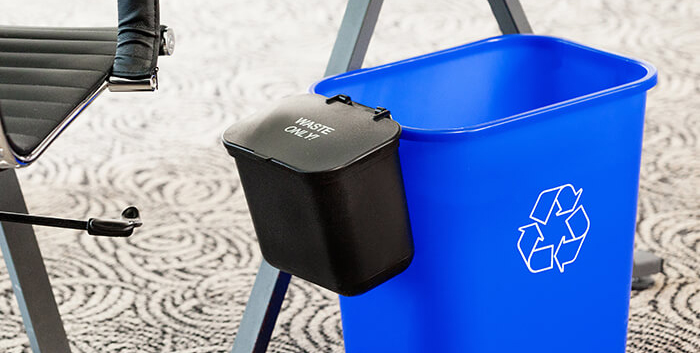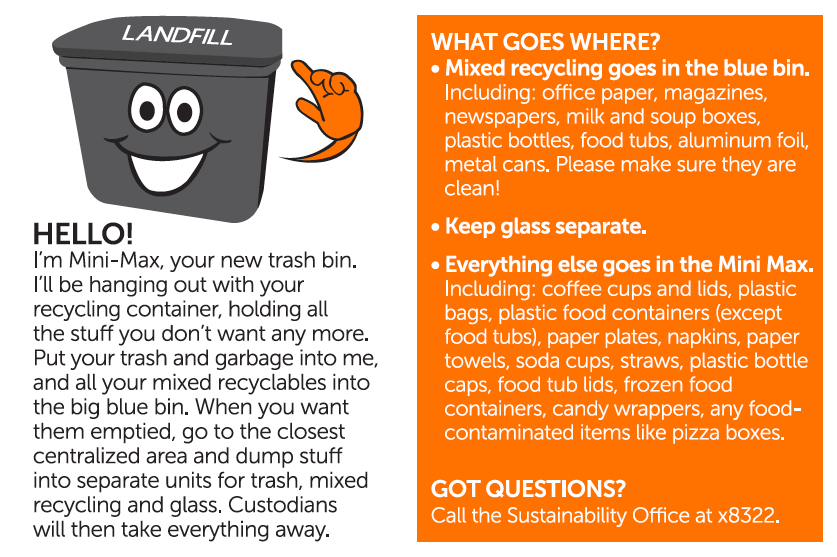So you’re looking to reorganize waste collections from office deskside? As I covered in part 1 of this blog, there are compelling reasons to rethink collection arrangements that were originally designed for trash-only collection and that often still present structural barriers to recycling. I advocate a proven system that maximizes recovery in offices through the use of small trash baskets combined with regular-sized recycling baskets and, importantly, the expectation for office workers to empty both baskets into larger centralized bins. The basic costs and logistics to implementing this arrangement are relatively modest. The small clip-on trash baskets and recycling baskets (if not already provided) are relatively inexpensive. But as we’ve discussed, implementing the different variations of this system frequently provoke some level of protest from staff and faculty. The real investment comes with the need to plan a careful roll-out campaign to overcome this resistance and ensure a high level of participation.
With this blog, I want to offer some of the essential best practice strategies that dozens of colleges and universities have used to plan an effective campaign.
Building Administration & Stakeholder Support
While the technical decision to reorganize collection service may rest with facility managers, it’s crucial to get the support of upper administrators at the outset. Irritated professors don’t complain to the custodial manager, they go straight to the dean or vice president. As the people with the ultimate authority to make or break the new arrangement, they need to understand the reasons for the change and the benefits to the institution to ensure they’re willing to defend and even endorse it. Portland Community College (PCC)’s experience rolling out the small-trash / self-service system in 2015 illustrates this point. While one of the school’s deans was quick to “lay down the law” stamping the arrangement as the new norm, across campus a different dean quietly allowed the administrative staff underneath them to discard the small trash baskets in favor of their old bins. Kent State University began a two-phase project the same year, reorganizing their indoor collections around centralized all-in-the-hall bin stations. The first phase to remove wastebaskets from classrooms and adjust centralized bin locations went forward smoothly, but persistent complaints from one building, in particular, resulted in the vice-president overseeing facilities halting the phase two conversion to self-service deskside collections in mid-stream.
Getting them on your side involves making the arguments and showing you have a well-thought-out plan. We reviewed the cost, labor, and waste reduction benefits in part one of this blog. To the degree you have data, use it to project the potential impact on the size and circumstances of your institution. Be upfront about the potential for complaints, and show how you plan to roll out the campaign with a communication and engagement strategy to win people over. Point to the dozens of other schools that have successfully implemented changes without causing “the sky to fall” (I’ve organized a Google Sheet with over 60 colleges and universities that have implemented some form of small-trash / self-service deskside collection).
The folks in the corner office may have the explicit authority to red or green-light a project, but other key stakeholders also hold soft-power to influence a smooth rollout. Department heads and building coordinators can be allies or obstacles when the time comes to introduce the change to their respective areas of campus. Too often overlooked, the custodians on the front lines are equally critical to consult. They are likely to experience any pushback first hand and can either be ambassadors helping smooth over rebellion or play an active role in stoking it. Even aside from reorganizing collection arrangements, the smart recycling or sustainability manager understands that custodians are important allies to cultivate as eyes and ears to how waste and recycling are working in practice. Each of these groups needs to be actively engaged when designing the new system, both to get their input and signal respect for their experience and role in implementing it.
Designing the New Deskside Arrangement
A first step, of course, is to settle on the exact bin configuration and service arrangement to roll out. If a core objective is to encourage recycling and waste recovery on a competitive footing with the landfill, you could in theory leave folks with a basket for recycling and nothing for trash. While I’ve heard instances of this arrangement, the 2015 Keep America Beautiful Recycling at Work study showed this to increase contamination in the recycling stream. I’d be curious to see examples where this has worked, but my recommendation, in general, is to always pair trash and recycling bins together, no matter the setting.
Education sticker placed on the small trash baskets provided to Portland Community College staff and faculty
What if you collect multiple separate recovery streams? Do you provide separate baskets for paper vs cans and bottles? What if you collect food waste from office locations? The confined footprint of an office workstation, not to mention the cost and complexity of providing three or four separate baskets to all staff makes this a challenge. Given the potential (not to mention perception) of odors and flies, don’t bother with collection baskets for food waste. Encourage people to drop their apple core, etc. directly into the centralized compost bins wherever they’re located. If you have a dual-recycling stream system, you do ideally want people to sort paper from cans and bottles at the source. You can’t reasonably ask collection workers to separate these after the fact, and you can expect at least some percentage of office staff to resist this step if asked to empty the contents of a single recycling bucket into multiple recycling bins in the hallway. In that situation, my advice is to designate the main, large bucket for paper since that makes up the overwhelming percentage of waste in most offices. With one small basket for trash already hanging from this paper bucket, you could reasonably include a second one for cans/glass/ plastics, or simply instruct people to walk these directly to the centralized bins as Stanford University does. Whatever configuration you go with, make a point to match the baskets with the same color-coding system used for the centralized bins.
Glendale Community College’s Zero Waste branding logo used on stickers to identify the offices of volunteers
Next question, will custodians service the deskside baskets? Just one stream? Or will you instruct people to empty their own baskets? Most but not all schools I’ve looked at go with the last option for reasons I’ve previously covered. There are legitimate reasons, however, to maintain some form of deskside service. First, you must have a robust network of conveniently located centralized bins in place. It’s reasonable to ask people to walk 100 or so feet to empty their baskets. But if an under-developed network of centralized bins requires them to walk further, or potentially go up or down stairs, you can expect an exponentially higher level of resistance. You also have to gauge the political situation. Do you have strong administrative support to push a complete self-service system through? If not, you may want to maintain custodial service but look for ways to shift it to better support recycling. If daily service for trash is the legacy arrangement, consider reducing this to twice weekly and giving over the other three days to emptying the recycling baskets. Or again looking to Stanford, simply flip the service on its head, so custodians service recycling exclusively while staff empty their own trash to centralized bins.
Last question, what about the plastic liners? You don’t need them. People will insist they’re necessary, but it’s not true (for deskside bins at least). Again, the vast majority of waste generated in offices is paper and other inert materials that do not leave residual goo or odors. Liners for the small 3-quart trash baskets are not easy or cheap to source, and the ick factor rarely turns out to be a major issue. Politically, you may want a backup arrangement to mollify concerns. IUPUI offers to have custodians clean out the basket on request. Other schools like Raritan Valley Community College in New Jersey make liners available only upon request. In practice, these arrangements help overcome resistance at the outset, but rarely get used.
Start With Test Pilots
Whatever system you come up with will need to be road-tested before rolling out campus-wide. Pilot projects are advisable for any significant operation change, and I would argue they’re essential in this case. Best practices can point the way, but the unique cultures and operational features of a campus can expose their limitations. Pilots allow you to quietly test and adapt the model locally, in the process demonstrating to higher administrators that you’re doing your homework. They can also provide a homegrown case study, showing both that people are capable of adapting to the new system and that it delivers on the benefits you’re claiming.
I like the approach University of North Carolina at Charlotte. took. They conducted four successive pilots as a prelude to their 2011 campus-wide rollout. While this may sound like overkill, doing multiple rounds was part of a conscious strategy to build support. The first round was done within their own Facilities staff offices, followed by a second in an administration building, a third in a general academic building, and the final one in the campus library. This approach allowed them to study the model with different audiences. It also allowed them to demonstrate sensitivity to staff and faculty concerns by conspicuously incorporating the feedback they received when refining the model for the next pilot. I also think the order they followed was important. By starting internally with Facilities, they were able to test the basic concept on a controlled audience without the risk of bad publicity that could follow a poorly received pilot in an outside department. It also showed they were “walking the talk”, modeling the service arrangement they would be asking others to adopt. Including an administration building, as Charlotte did in the second round, can also be strategic. IUPUI similarly planned a pilot for their administration building that included the school’s chancellor’s office. When the time came to expand campus-wide, their sustainability office was able to hold him up as exhibit A that anyone could reasonably be expected to adapt to the small-trash / self-service system. Finally, while a third and fourth round pilot may not be necessary for schools with limited sustainability bandwidth, in UNC Charlotte’s case, testing the system in an academic building and library allowed them to refine the system in diverse settings with unique operational and staff considerations.
Measure The Impact
Make sure you’re gathering metrics from the pilot to help sell the program to the rest of campus. Even if you don’t have the ability to measure impact across campus over the long term, it is worth dedicating the extra staff resources during the pilot to measure 3 key items:
- How much trash and recycling is collected before and after the change. The longer you can measure this the better, but I recommend at least a week and preferably a month in both instances.
- Hours of custodial labor saved. This can be hard to quantify, but do your best to at least come up with back-of-the-napkin numbers that can be extrapolated to other areas of campus.
- If eliminating bag liners from deskside bins, do the math on how many are being eliminated as well as the cost savings.
If the staff or volunteer time is available, I also encourage doing before and after waste audits to measure the contamination and capture rates. Contamination as we know is a major issue, and there is strong evidence that the small trash basket can significantly reduce this.
A final element is to survey of office staff participating in the pilot. Surveys can be used to flag practical issues such as whether centralized bins are sufficiently convenient for people to access. They give you a pulse of how the changes are being received and can flag issues likely to be raised by others. Surveys are useful to identify potential supporters to provide testimonials or features as “satisfied customers” in the outreach. Portland Community College used their survey results to develop talking points used to market the program to other staff. Elaine Cole, Sustainability Coordinator for PCC’s Rock Creek Campus noted that among other things, the survey showed an “added health benefit that staff and faculty saw from having to get up from their desks to empty their own trash bins.”
IUPUI went an additional step, conducting two rounds of surveys, before and after their pilot launch. In addition to gauging direct reaction and feedback, they included questions to measure how the new system and accompanying education influenced staff member’s attitudes and knowledge about recycling (both increased significantly).
Preparing to Expand Campus-wide
The pilot(s) are now complete and the feedback received has allowed you to adjust the program design. It’s time to develop an implementation strategy to expand campus-wide. First, how will the new system be rolled out across campus? There are three basic models for expanding: 1) start by offering the arrangement to volunteers, before eventually making it mandatory time; 2) convert entire buildings or sections of campus in scheduled phases, 3) make one large push to convert the entire campus at the same time. Each approach has its benefits and downsides.
Glendale Community College in Arizona took the volunteers-first approach. This allowed the program to bypass resistance from skeptical staff and faculty while relying on the supportive ones to demonstrate it’s workability. The positive reviews of the volunteers then lent momentum for the college president to eventually declare the new system mandatory in 2014. Chanda Fraulino, the school’s recycling coordinator said the separate service arrangements during the volunteer phase had the potential to create confusion with Custodians. They got around this, however, by asking the volunteers to add a static cling with the Zero Waste logo to their office window. This allowed the custodial staff to know which offices to service differently. While in a perfect world with strong administrative support and ample budget it would be preferable to go “all-in”, she says the phased approach worked well for her campus.
A majority of the schools I’ve canvassed have taken the second approach, phasing in the new arrangement over a multiple-year period. The University of Tennessee, IUPUI, University of Washington, Appalachian State, Georgia Tech, and University of Missouri, Columbia are examples of schools that have taken this tack. In some cases the timeline is driven by budget considerations, expanding as money is available to replace bins. The slow, steady expansion also allows sustainability and facilities staff to coordinate the infrastructure switch out and education logistics in a deliberative yet still manageable routine. It gives them time to fine-tune any complexities or issues and, importantly, allows for greater hands-on engagement with stakeholders and office staff, before moving on to the next areas of campus. A smaller number of schools, including UNC Charlotte, have taken the last approach, ripping off the band-aid, as it were. While this option creates challenges to directly educate a large percentage of office staff, it has the advantage of simply getting the job done. The implementation requires a full-time effort over a few weeks or months, but then sustainability staff can largely move on to other projects.
I’ve organized a Google Sheet with details about more than 60 colleges and universities that have implemented some form of small-trash / self-service deskside collection. I encourage readers to contact me directly with additions or updates to this list. Email: alecc@buschsystems.com















